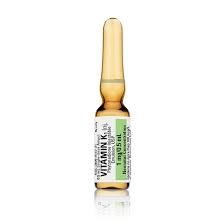A nurse is caring for a client who asks why her newborn is receiving a phytonadione injection. Which of the following statements should the nurse make?
This medication prevents your baby from developing bleeding problems."
"This medication enhances regulation of your baby's temperature."
"This medication enhances your baby's immune response."
"This medication prevents your baby from developing jaundice
The Correct Answer is A
Choice A Reason:
"This medication prevents your baby from developing bleeding problems." This is the correct statement. Phytonadione is given to newborns to prevent neonatal vitamin K deficiency bleeding (VKDB), which can lead to serious bleeding problems, including intracranial hemorrhage.
Choice B Reason:
"This medication enhances regulation of your baby's temperature." Phytonadione does not have any direct impact on the regulation of a baby's temperature. Its primary purpose is to prevent bleeding issues.
Choice C Reason:
"This medication enhances your baby's immune response. Phytonadione does not enhance a baby's immune response. It primarily addresses vitamin K deficiency and associated bleeding risks.
Choice D Reason:
"This medication prevents your baby from developing jaundice." Phytonadione is not used to prevent jaundice. Jaundice is typically related to bilirubin levels and is managed separately from vitamin K supplementation.

Nursing Test Bank
Naxlex Comprehensive Predictor Exams
Related Questions
Correct Answer is C
Explanation
Choice A Reason:
Pain sensation is incorrect. While assessing pain is important, it's generally secondary to addressing the life-threatening cardiac issues in hypothermia. Pain assessment can be done once the client's core temperature is stabilized.
Choice B Reason:
Urinary output is incorrect. Monitoring urinary output is essential for assessing kidney function and fluid balance, but it is not as immediately critical as assessing and addressing cardiac concerns.
In a client with hypothermia, the priority for the nurse to monitor is:
Choice C Reason:
Heart rhythm is correct. Hypothermia can affect the electrical conductivity of the heart, potentially leading to life-threatening arrhythmias. Monitoring the client's heart rhythm is essential to detect any abnormalities and intervene promptly if necessary. While all the listed parameters are important, the cardiac status takes precedence due to the immediate threat it poses to the client's life.
Choice D Reason:
- Muscle strength is incorrect. Monitoring muscle strength is important to assess the client's overall neurological status, but it's not the top priority when there is a risk of life-threatening arrhythmias due to hypothermia.
Correct Answer is C
Explanation
c. Roasted salmon
The nurse should include roasted salmon on the tray for the client who follows a kosher diet.
Kosher dietary laws prohibit the consumption of shellfish such as clams and shrimp, as well as pork products like pulled pork sandwiches. Roasted salmon, on the other hand, is a permissible food item in a kosher diet.
It's important for the nurse to be aware of the client's dietary restrictions and preferences to ensure that they receive appropriate and culturally sensitive care.
Whether you are a student looking to ace your exams or a practicing nurse seeking to enhance your expertise , our nursing education contents will empower you with the confidence and competence to make a difference in the lives of patients and become a respected leader in the healthcare field.
Visit Naxlex, invest in your future and unlock endless possibilities with our unparalleled nursing education contents today
Report Wrong Answer on the Current Question
Do you disagree with the answer? If yes, what is your expected answer? Explain.
Kindly be descriptive with the issue you are facing.
